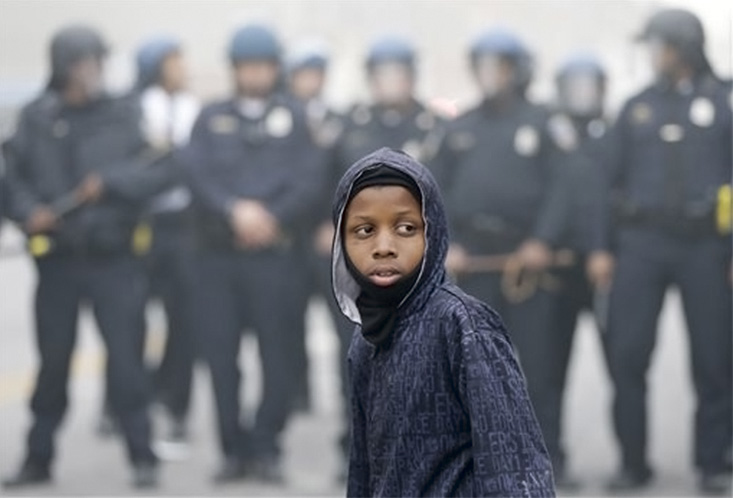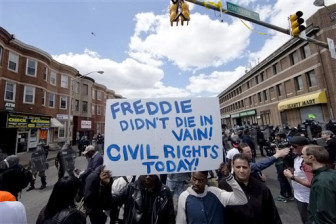
Matt Rourke / AP
Police move a protester back following the funeral of Freddie Gray in Baltimore.
Even before riots broke out this week in the Sandtown-Winchester section of Baltimore over the death of 25-year-old Freddie Gray in police custody, Craig Jernigan had been planning to organize young people to do a neighborhood cleanup in the area.
The only difference is that before the riots, the cleanup was meant to help prepare for a community festival Jernigan had planned for a few weeks later.
Now, the cleanup serves a much broader purpose — both physically and symbolically. Jernigan is preparing to lead young people to pitch in and pick up in the aftermath of the destruction that disaffected young people wrought in response to what has become a pattern of police abuse of young black men.
At least 15 officers were hurt during the protest, including six who were hospitalized, police said, the Associated Press reported. There were nearly 200 arrests, AP said.
“I was going to do a cleanup anyway,” said Jernigan, Baltimore program director of Youth Advocate Programs Inc., an organization that works to keep young people out of compulsory placements. “But now I’m going to go where they need the most help.”
He is one of several adults there who are now focusing on finding teachable moments for youths.
Helping to clean up instead of destroying property will help imbue young Baltimoreans with a sense of pride and connectedness, Jernigan said.
“It teaches empowerment and ownership,” he said. “It gives them a sense of ownership and it gives them a sense of pride to be right there to do something meaningful.”
He was one of many people who took to the streets to talk and listen to young protesters on the same day that Freddie Gray, who died of a spinal injury after being taken into police custody earlier this month, was laid to rest.
As criticism toward city and state officials continues to mount for not doing more to anticipate and counter the riots before they got started, Jernigan — a veteran youth service worker in Baltimore — believes the rioting is reflective of the sense of disconnectedness that many young Baltimoreans feel from society and their anger over negative encounters with police.

Matt Rourke / AP
People gather Tuesday, April 28, 2015, in Baltimore, in the aftermath of rioting following Monday’s funeral for Freddie Gray, who died in police custody.
“If you talk to anyone that does the work that I do on the front lines, those folks out there in the trenches are saying, ‘We knew it.’ Everyone knew it was going to happen. It was just a matter of time,” Jernigan said.
“A lot of the youth we deal with express their frustrations on how they’re treated, how they are treated as juveniles period, and they’re operating off of emotions right now,” he continued.“This is all coming from their gut. They’re not using their head.
“They just see what they’ve been going through and react from their gut. That’s how you can tell this was going to happen.”
Jernigan walked to the area most heavily hit by the violence Monday night to interact with young protesters.
“It was surreal. I never experienced anything like this,” he said. “I just walked through the area where all the youth were doing whatever they were doing.
“Many were coming up to me. They would talk to an adult who would listen. A lot of them were saying they’re doing this because ‘They don’t care about us,’” Jernigan said. “A lot of them have seen their peers affected in one way or another by some type of police brutality and they see what’s on social media. Social media is assisting youth in their rage the way they see what happens in other cities.”
Jernigan said he believes the young people’s accounts of negative experiences with police because adult members of his staff have reported similar encounters with Baltimore police.
He said he got the sense that the young people who vandalized a CVS store and other nearby businesses targeted those places because they were not seen as places that hire young people from the community.
“They went to a lot of those places where they don’t see themselves getting jobs at,” Jernigan said.
Ernest Dorsey, head of all youth programs for Baltimore Mayor’s Office of Employment Development, said those who harbor such views may not be aware of what’s in the works.
“We just had a meeting with CVS — myself and the business services manager — two or three weeks ago to talk about training opportunities and possible career paths in CVS,” he said.
Dorsey also said the city has a One-Stop Career Center — known as the re-entry center — housed in Mondawmin Mall, which has been heavily hit by violence in the protests over Gray’s death. He said a food market in the mall has hired several young people through the re-entry center.
Dorsey also downplayed suggestions that the city’s closing of recreational centers in recent years due to budgetary constraints helped increase pent-up angst. “I think the centers that were closed were centers that needed a lot of work,” he said.
He added that several new “state-of-the-art” centers have opened since a series of older ones were closed. “To be very honest, a lot of people weren’t using them anyway,” he said.
The city is working with different agencies through the city health department and public schools to provide assistance and social workers to deal with the issues the riots have brought to the fore, he said.
“I think what it all boils down to is everybody is looking at how can you make this a teachable moment,” Dorsey said. “Nobody has blinders on. Everybody realizes that there are real issues, and it goes beyond the young man who died in police custody.
“So how do we make this a teachable moment where we talk about young people and young people talk with us so they can get their point across in a peaceful manner and a constructive way?”
Dorsey said his office is currently in the throes of planning for summer jobs. Thanks to some 80-something employers, he said, plans are underway to place about 5,000 Baltimoreans in summer jobs starting at the end of June.
The need, however, is much greater — 7,000 young Baltimoreans registered for summer jobs, he said.
“It’s definitely a case of the glass being more than half-full,” said Brice Freeman, a spokesman for the Baltimore City Office of Employment Development.
William J. McLennan, executive director at Paul’s Place Inc., which runs an after-school program, also said staff planned to give young people an opportunity to discuss the issues that arose through the riots this week.
“This feels scary,” McLennan said. “And you have to process it. You have to learn from it.” These riots reminded him of the 1968 riots after the assassination of Dr. Martin Luther King Jr., he said.
“Once school reopens, we’re going to have those discussions,” McLennan said.
























